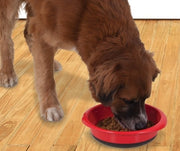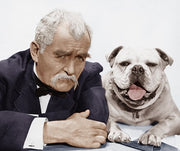Housebreaking Your Favorite Dog: A Step By Step Process

Of all the methods there are to housebreak a dog, one of the ways I find most effective is crate training. Many people complain to me about how their dog simply won’t learn to go outside. Here’s a simple 3 part process I use that can get even the worst dog house trained in 2 weeks or less. I call it the “House Training Triangle.” This method is very easy and effective if followed correctly. The reason I like this system is because it teaches the dog to hold it and understand what they’re doing right when they do go outside. Many people don’t use crates when housebreaking. They just take their dog out every hour which is fine if that works for them. I find that the crate training method equals fewer accidents in the house while training. The more accidents your dog has in the house the more the floor smells and that scent tells the dog that it’s an OK place to go! So more accidents = more accidents! Furthermore, when accidents occur they will be corrected or reprimanded and you don’t want to start your and your new dog’s life together off with too much negativity.
First thing first, you’ll need a crate. You don’t want to get one too small because it’ll be uncomfortable. You don’t want to get one too big because they’ll walk to one side of the crate, do their business, and lie back down on the other side. Your goal is to get a crate just a little larger than the dog; height, length, and width-wise. If you’re planning on continuing to use the crate after the housebreaking is finished then I’d recommend getting a larger crate with a divider inside. This way you can make the area larger and smaller as needed. Now let’s break down the process of how I do this…
Step 1. Dogs sleep in a crate at night. First thing in the morning take the dog out of the crate and go DIRECTLY outside. DO NOT let the dog out and roam even for 10 seconds. They WILL have to go and your floor will be the victim. Nothing is worse than starting your day by cleaning pee off your favorite area rug. I’d recommend either picking them up or attaching them to a leash to take them outside. This will ensure they won’t go on your floors on the way out the door. Remember prevention is the goal here.
Step 2. Now you’re outside, say your command immediately. I say “Get Busy”, you might prefer to say something else. Whatever it may be, say it every few seconds and simply wait them out. They WILL have to go because they’ve been holding it in that crate. Once you see them doing their business repeat the command once more. The last step here is to heavily praise them and give them a treat. Once they’ve done their business outside (preferably both) they can go back inside the house.
Step 3. Now they’ve done what we want so they have earned supervised and I mean SUPERVISED free time in the house. This will allow you to quickly catch your dog in the act if they happen to have an accident in the house. If they happen to mess in another room and you find it 2 hours later you may as well just clean it up and let the dog be because reprimanding after the fact is completely pointless. I’d recommend a baby gate to block off other rooms in the house or just simply shut all doors. You don’t want the dog out of your sight for too long or they can quickly find trouble. Big dogs and little dogs require different lengths of free time in the house. Big dogs can stay out for much longer as they can hold it for longer. Smaller dogs need quicker turnarounds so maybe 1-2 hours free time at first with a smaller dog and 2-3 hours for larger dogs. After they get free time in the house we put them back in the crate for about the same amount of time that they were loose. If they got 2 hours of free time then we put them back in the crate for the same length of time.
Notice they’re right back in the crate where they started, hence the term “House Training Triangle.” This is the 3 part process that’s repeated throughout the day for the next couple of weeks. They go from: the Crate to the Outside to the Free Time in the house. There are several tweaks you’ll make in this process over the next 2 weeks. Every day your goal is to eliminate a little crate time and add a little more free time in the house. So on day 1 if they spent 3 hours in the crate and had 3 hours of free time in the house you’ll take off 15 minutes in the crate the next day and add that to the free time. By the end of the 2 weeks, your dog should be spending 30 minutes in that crate and 5-6 hours of free time in the house. Eventually, the crate is eliminated. Another thing I recommend is to feed them in the crate for about 10 minutes before you take them outside to do their business. Much like ours, their systems get moving pretty quickly after they eat and if timed correctly you can save yourself a lot of cleanup.
One more thing to keep in mind is to give the dog something fun to do in the crate. Toys, chews, comfortable blankets, etc. There are a lot of fun accessories that will help your dog warm up to a new environment. Your dog spends a long time in the crate – having fun inside will keep your dog from becoming lonely. The crate isn’t supposed to be a dungeon, but a place to learn and have a positive experience. When teaching a dog any new training technique I always keep it positive. It is important that they learn the correct way and that they look at me as not only a teacher but as a friend. Ruff.
– Brandon
Next article

Related posts
View all-

Keep Your Pets Safe During the Holidays
The holiday season brings joy, festivities, and a break from the usual routine. While you're enjoying the celebrations, it's important to remember that the holidays can present unique challenges for our furry family members. The new sights, sounds, and people can be overwhelming, and common festive items can pose unexpected risks.
Read Article -

Holiday Gifts for Every Pet Personality: The Ultimate Guide
The holiday season is finally here, and for many of us, that means finding the perfect presents for the ones we love most—our pets. Whether they are a steadfast dog who never leaves your side or an independent cat who graces you with their presence on their own terms, our pets are cherished members of the family. They deserve to celebrate right alongside us, stocking stuffers and all.
Read Article -

How to Keep Your Pet Calm During Thanksgiving
Thanksgiving is a time for family, friends, and food, but for our pets, the holiday can be overwhelming. The sudden change in routine, unfamiliar faces and scents, and increased noise can trigger significant stress. Understanding why your pet might feel anxious is the first step toward creating a peaceful holiday experience for everyone, including your furry family members. This guide offers calming tips for pets and practical solutions to ensure your dog or cat feels safe and secure during the festivities.
Read Article




